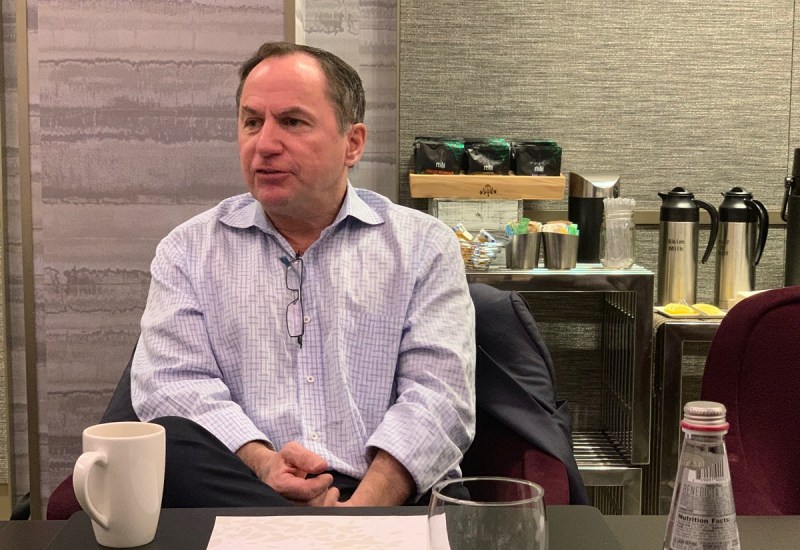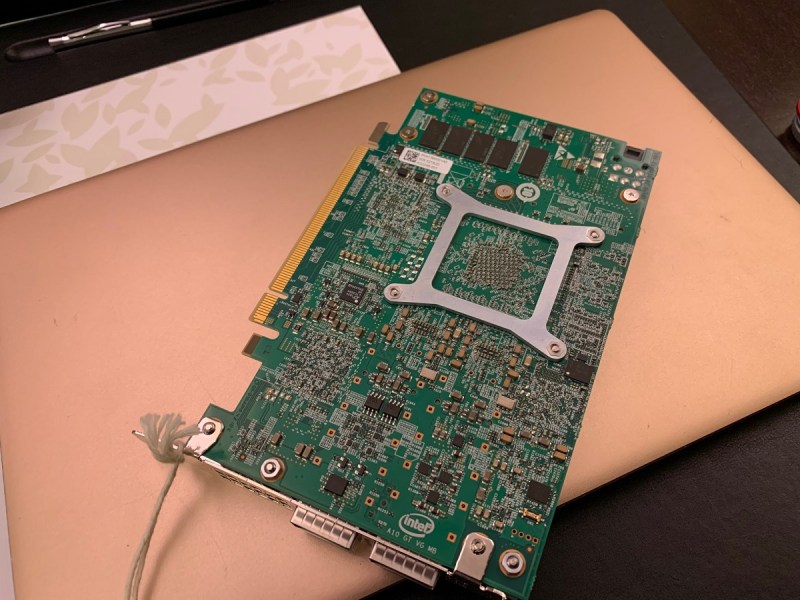Only the strong assets survive. That’s what I said after Bob Swan, the newly appointed CEO of Intel, talked about his view of paranoia in business — a legacy made famous by early Intel CEO Andy Grove, who believed “only the paranoid survive.”
I sat down with Swan and Intel executives Sandra Rivera (senior vice president of network platforms group) and Dan McNamara (senior vice president of programmable solutions group) last week, along with five other reporters. It was the first chance I had to sit down with Swan, who served as chief financial officer at Intel for a couple of years before he was named Intel’s acting CEO last year (after prior CEO Brian Krzanich left amid a personnel scandal). On January 31, Swan was named permanent CEO.
In advance of MWC Barcelona (formerly Mobile World Congress), Swan and his executives wanted to explain Intel’s strategy around 5G wireless networks, and how it will generate a tsunami of data that will be processed by Intel chips in both clients on the edge and servers in the datacenter.
I have now interviewed every CEO of Intel except for founding CEO Robert Noyce. By far, Swan is the most humble. He is the seventh CEO in Intel’s 50-year history, and he presides over a company with $70.8 billion in revenues and the biggest share of the PC and server microprocessor market.
June 5th: The AI Audit in NYC
Join us next week in NYC to engage with top executive leaders, delving into strategies for auditing AI models to ensure fairness, optimal performance, and ethical compliance across diverse organizations. Secure your attendance for this exclusive invite-only event.
Here’s an edited transcript of our interview.

Above: Intel CEO Bob Swan speaks with reporters in Palo Alto, California.
Bob Swan: We thought it would be interesting to have a discussion in advance of Mobile World Congress next week. It’s a bigger one for us than ever, because of the opportunity it represents, and also because of what’s important in that market right now and the transformation of the network, which is probably underappreciated by a lot of folks.
Let me start with what we’ve been up to as a company. We’ve been in the midst of a transformation, from a PC-centric to a data-centric company. That’s been going on for several years now. What that means is, we have a much broader range of products and services for our customers. We’re redefining and evolving what “Intel Inside” really means.
By Intel Inside, as you know, historically the brand Intel Inside was a (central processing unit) CPU inside of a PC. The way we look at the world today, it’s a CPU inside of a PC, inside of a datacenter, inside of an automobile, inside of industrial, inside of retail. With this explosion in needs and demand for data, whether it’s for consumers or for enterprises, we have more and more CPUs inside more and more devices. Where they go is much broader.
In addition to that, it’s not just about CPUs. The “Where” is much broader, but the “What” has expanded from CPUs to field programmable gate arrays (FPGAs) — you might know a thing or two about those — to GPUs, to modems, to memory. The reason for all of that technology is we go back to a world where we see the needs for data exploding. We have the capabilities, the wherewithal, the bandwidth to bring more and more technology. Intel’s broader array of products is powering the technologies that power the world. That’s what we’ve been up to for the last several years.
The implications of that are — the market that we’re going after is as big as it’s ever been. We talk about not being 90-plus percent market share of $60-plus billion total available market (TAM). We are talking about being more like a 25 percent market share of a TAM that’s $300 billion. Again, the expanded TAM is a function of more products, more technologies in more places. We’re looking at a $300 billion TAM. What that means for us is the prospects for growth are fairly significant, because the opportunities in front of us are relatively big, by bringing our core competencies, the things we’ve always done, into a much broader footprint.
Over the last three years — year 48, year 49, and year 50 in the company’s history — we’ve had record financial performance. We’ve essentially transitioned from a company that, five years ago, 70 percent of our revenues and profits and cash were derived from a PC, to today, where 50 percent, roughly, is derived from what we call this collection of data-centric businesses. Much bigger TAM, much more prospects for growth, and we believe a relatively decent tailwind as we look forward.

Above: Andy Grove, former CEO of Intel.
The third point I would make is, a big driver of that tailwind is 5G and the role that 5G will play in driving more innovation. Not just at the network, but at the edge. As communications and compute converge, it means the relative importance of the network is much higher. We have a relatively strong and growing position at the network, and those networks have to transform to deal with more and more data in a 5G world.
Transforming what we’re doing, much bigger TAM, much broader array of products and customers, and 5G, we believe, will be an accelerant of the innovation, which in turn will drive more demand for our products. Not just more demand for network-oriented products, but what it means — 5G will be an accelerant of the data that gets processed on billions and billions of connected devices at the edge. It’ll create needs for transformation of networks, but also needs for more compute, more storage, more analytics. That’s that broader TAM we’ve been going after for a couple of years now.
We step back and look at — we feel great about our transformation. We’re a couple of years into it. Our TAM is as big as it’s ever been, and our capabilities are as broad and as diverse as they’ve ever been. We’re very excited about the investments we’ve been making and how well we believe we’re positioned as we go into 2019, where 5G begins to build out. Next week we’ll talk more about our products. Today is just to give you some context about what that all means. That’s the backdrop.
Sandra Rivera: As Bob indicated, data is growing. In fact, data is growing faster than at any other point in our history. We know that just in the last year, half of the world’s data has been created. But only between 2 and 4 percent of that data is actually utilized. This data-centric opportunity — to move, store, and process all that data and turn it into value — is a great opportunity that we’re driving forward in terms of our product portfolio and our technology innovations.
As Bob also mentioned, the network transformation is a critical part of how we enable all that data to be turned into value, because of that true convergence between computing and communications that’s accelerate by 5G. If you look at what we define as the network, between your devices and between the datacenters, there’s this thing called the network that not many people often think about. You can think about it like oxygen. You don’t miss it until it’s not there. You just have an assumption that, magically, your data shows up on your device and you’re able to download or upload that data.
Increasingly, because with 5G you have 1,000 times the bandwidth and 100 times the peak data rate capability and an order of magnitude lower latency, you’re now able to move compute much closer to that point of data creation and data consumption. For many issues — issues of bandwidth, issues of latency, issues of cost, issues of security, issues of data sovereignty — more and more of that data, really almost half of the data, is going to be dispositioned at the edge, and not in the distant datacenter or cloud someplace.
That dispositioning of that data requires a network that is a high-performance computing platform, where you can do data analytics, where you can disposition the data in terms of: Does it need to be moved someplace else? Can it be discarded at that point? Can it be used in some way to take action or make a decision? That’s the opportunity that we see building out around this edge, around where the network and the premises come together.
We have a broad portfolio of products, clearly built on our strength in computing, where networks are now a collection of high-performance computing platforms. With 5G, we see the same cloud-scale opportunity that we saw in the buildout of the cloud, where all of that edge opportunity, all of the access now becomes cloud platforms. They become computing platforms where you have analytics capability, where you’re moving the traffic, where you’re storing the traffic, where you’re processing all of that traffic.
We have products that we’re announcing next week, but really, network SOCs, edge SOC products, FPGA products that Dan will talk about to begin processing all that data, turn it into value, and allow that flow of traffic and the dispositioning of that data much closer to the point of data creation and data consumption, whether that’s a device we’re familiar with — a phone, a laptop, a tablet — or a new class of devices, as Bob mentioned. Robots, drones, factories, cities, smart lighting, smart cameras, smart sensors of all types. We’re very excited about that opportunity.

Above: Intel FPGA board
Dan McNamara: To speak to what Bob just talked about, we’ve been integrating and transforming for three years as part of Intel. We were formerly Altera. We joined at the beginning of 2016. If you recall, when that deal was announced, it was all about the cloud and the datacenter, in terms of FPGAs being able to accelerate the infrastructure of the datacenter and do some of the workloads in the cloud. That’s true, and we’re doing very well there.
What I believe was missed there was that the network was missed by everyone. The fact that FPGAs have spent — basically, we grew up in the network. FPGAs, for 20 years, have been a good — what I call a data shovel. It’s very good at packet processing and moving data with very high throughput and very low latency. We’ve traditionally been in the wired network. We’ve been in the wireless network from 2G to 3G to 4G. We’ve done very well there.
What Sandra is talking about — I can’t even use the word transformation strongly enough. It’s cloudification of the network. What’s exciting about this is the FPGA comes in and accelerates the network no matter where you are, whether you’re on an access pole with an antenna for 5G or you’re in the baseband or you’re in the core of the network. It sits right next to a Xeon processor.
If you think about what we bring to market as Intel — this is one of the devices we’re going to announce next week. This is a programmable accelerator card. It has a FPGA on it. It also has two network interface chips from Intel. You load this into a server with a complete software stack and IP availability. A service provider could leverage this in the core of their network by accelerating network functions or infrastructure, or at the edge. The world today is impatient and distracted. This latency need is important. FPGAs plus a Xeon processor or some of the SOCs we’re building are so pivotal in delivering this low latency and high bandwidth to the users.

